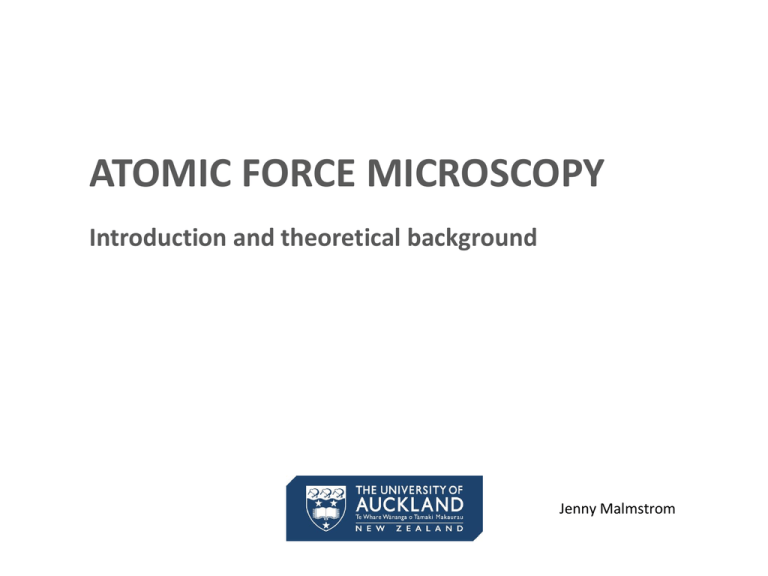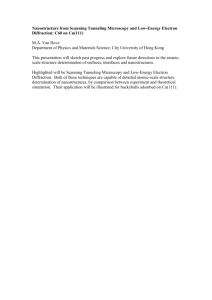Atomic Force Microscopy
advertisement

ATOMIC FORCE MICROSCOPY Introduction and theoretical background Jenny Malmstrom AFM invented by Binning and co-workers in 1986. Belongs to the Scanning Probe Microscopy family Binning et al., Physics Review Letters 1986 AFM invented by Binning and co-workers in 1986. Belongs to the Scanning Probe Microscopy family AFM, atomic force microscopy [1] Contact AFM Non-contact AFM Dynamic contact AFM Tapping AFM BEEM, ballistic electron emission microscopy[2] CFM, chemical force microscopy C-AFM, conductive atomic force microscopy[3] ECSTM electrochemical scanning tunneling microscope[4] EFM, electrostatic force microscopy[5] FluidFM, Fluidic force microscopy[6][7][8][9] FMM, force modulation microscopy[10] FOSPM, feature-oriented scanning probe microscopy[11] KPFM, kelvin probe force microscopy[12] MFM, magnetic force microscopy[13] MRFM, magnetic resonance force microscopy[14] NSOM, near-field scanning optical microscopy (or SNOM, scanning near-field optical microscopy)[15] (Wikipedia 2015) PFM, Piezoresponse Force Microscopy[16] PSTM, photon scanning tunneling microscopy[17] PTMS, photothermal microspectroscopy/microscopy SCM, scanning capacitance microscopy[18] SECM, scanning electrochemical microscopy SGM, scanning gate microscopy[19] SHPM, scanning Hall probe microscopy[20] SICM, scanning ion-conductance microscopy[21] SPSM spin polarized scanning tunneling microscopy[22] SSM, scanning SQUID microscopy SSRM, scanning spreading resistance microscopy[23] SThM, scanning thermal microscopy[24] STM, scanning tunneling microscopy[25] STP, scanning tunneling potentiometry[26] SVM, scanning voltage microscopy[27] SXSTM, synchrotron x-ray scanning tunneling microscopy[28] SSET Scanning Single-Electron Transistor Microscopy [29] Binning et al., Physics Review Letters 1986 PRINCIPLE Physical probe that raster scans a specimen Key elements: 1. Probe 2. Detector & Feedback 3. Piezo actuators http://ssd.phys.strath.ac.uk/index.php/Scanning_tunnelling_luminescence Scanning Probe Microscopy Scanning Tunneling Microscopy (STM) Atomic Force Microscopy (AFM) Operate by using a small tip (the probe) to scan very closely across a surface, detecting forces present between the surface and the tip. Atomic scale resolution possible Can be operated in air and liquid Slow STM Allows: To see (1981) To manipulate (1988) • Signal origin is quantum tunneling effect • 0.1 nm lateral resolution and 0.01 nm depth resolution •Can be used to manipulate individual atoms, trigger chemical reactions, or reversibly produce ions by removing or adding individual electrons from atoms or molecules. Image of reconstruction on a clean Au(100) surface. • Very small scan ranges http://en.wikipedia.org/ STM image of self-assembled supramolecular chains of the organic semiconductor Quinacridone on Graphite. Scanning tunneling microscopy no limitation to crystalline structures ultimate resolution in ultra-high vacuum also other environments possible such as air and liquids but by far more difficult limited to metal surface problem of sample preparation AFM Atomic Force Microscopy (AFM) Signal origin from short-range forces between the tip and the sample: van der Waals, capillary, electrostatic 1 nm lateral resolution and 0.1 nm depth resolution Contact mode Tapping mode AFM COMPONENTS Figures from Wikipedia Cantilevers Length thickness Cantilever dimensions determine how easy to bend it is. Image quality depends on tip size and shape Tip trace contact point Slide courtesy of Duncan Sutherland Influence of tip sharpness Tip trace Tip trace Slide courtesy of Duncan Sutherland Contact Mode AFM Laser Detector Z Cantilever Tip Simple X,Y Not too affected by humidity Operation in liquid Feedback: Deflection of cantilever Damage to soft samples Slide courtesy of Duncan Sutherland Tapping Mode AFM Detector Cantilever oscillates can be driven at a resonant frequency ~10-500 KHz Piezoelectric material drives oscillations 10-100nm The surface acts to damp the resonance Feedback: Oscillation amplitude Slide courtesy of Duncan Sutherland Repulsive regime Attractive regime Phase imaging in tapping mode Delay related to tip surface interaction Phase shift Two regions on the surface with different Tip- surface interactions Slide courtesy of Duncan Sutherland Phase only really means something in the repulsive mode (more contributions in the attractive mode) Many of the more advanced imaging modes has to be run in the repulsive mode Not always possible MFP-3D Origin AFM Imaging in contact and tapping mode. Force curves in single or multiple points. Image large area with the Origin AFM (80um scan size), 15-20 um z-piezo Can do future liquid imaging (if we buy a ‘skirt’) Cypher ES Image relatively fast to a very high resolution of flat samples (e.g. nanofiber on mica) Image samples with features up to 5 um in height Flow inert gas into the imaging chamber Control the temperature of the sample stage (0-150 deg) Image by tapping mode in liquid (using blue drive) Applications available that needs a bit of learning and that will not work for all samples: AMFM EAFM SKPM Things we can modify the system to do in the future: Using perfusion cell to exchange solutions Electrochemistry (ports for electrodes available) AM-FM Viscoelastic Mapping Mode Quantitatively maps both the storage modulus (elastic response) and loss modulus or loss tangent (viscous response) with nanoscale resolution based on tapping mode, so it’s gentle and high resolution. Works in both gas and liquid environments Using both ground tone resonance and first overtone. Several feedbacks (A, A1, f). Need to calibrate tip on known sample. EFM: Electrical AFM High resolution technique. Has to be done in air. Need conductive probe. First tap along one raster line. Then do a non-contact trace (fly) with applied electric field and monitor forces on cantilever. “Nap” mode Can “see” hidden conductive elements under the surface of the material (carbon nanotubes in polymer) SKPM: Scanning Kelvin Probe Microscopy Monitors surface potential. Less resolution than EFM. Uses a conductive probe and applied a bias to the tip. Detects potential difference between tip and sample. “Napmode” SKPM is QUANTITATIVE PFM: Piezo responsive force microscopy Tune the tip in contact with the surface – which gives the resonance of the ‘combined system’. This can be used to investigate internal dipoles in the system and can also be used as lithography technique if the dipoles are rewritable. New developments: Improved optics – smaller laser spot Smaller cantilevers – faster scanning Fast scanning cantilevers are 10–20x shorter than conventional cantilevers The Cypher laser spot is perfectly sized for even the smallest conventional cantilevers. blueDrive Photothermal excitation SUMMARY AFM is a member of the scanning probe family. It uses a sharp tip on the end of a flexible cantilever to ‘feel’ the sample surface. Things AFM cannot do: Image very rough samples Image something inside another material Image something that cannot be deposited on a solid material Things AFM is particularly suitable for: Imaging hard nanostructures Imaging soft nanostructures (proteinfibers, polymers) Imaging single molecules on a flat substrate Imaging adherent cells








